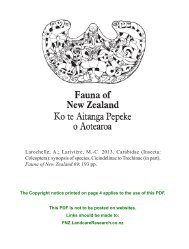Fauna of NZ 45 - Landcare Research
Fauna of NZ 45 - Landcare Research
Fauna of NZ 45 - Landcare Research
You also want an ePaper? Increase the reach of your titles
YUMPU automatically turns print PDFs into web optimized ePapers that Google loves.
<strong>Fauna</strong> <strong>of</strong> New Zealand <strong>45</strong> 29<br />
sinuous, laterally abbreviated sulcus ending in distinct pit<br />
halfway between eyes and epistome, in female about as<br />
long as wide, with shallow median depression instead <strong>of</strong> a<br />
transverse sulcus; apical margin rounded or slightly lobed<br />
on middle in male, truncate in female, in both sexes ciliate;<br />
underside with pit on postmentum bearing tight tuft <strong>of</strong><br />
bristles; vestiture on dorsal surface directed basad behind<br />
transverse sulcus or median depression, apicad in front <strong>of</strong><br />
sulcus or depression. Antennae short, extending to about<br />
middle <strong>of</strong> prothorax, reaching eyes with segment 2, with<br />
segments 1 and 2 similar in length and width to each other,<br />
segments 3–8 distinctly slenderer, segment 9 usually a<br />
little wider and larger than 8, segments 10–11 loosely articulated,<br />
forming a distinct 2-segmented club. Mandibles<br />
at distal half relatively slender, subparallel, with the outer<br />
edge slightly turned downwards, with three apical teeth;<br />
pharyngeal process absent; laterodorsal surface plurisetose.<br />
Maxillae with ill-defined galea, with 4-segmented palp.<br />
Prementum very large, concealing maxillae, plurisetose, labial<br />
palp 3-segmented, invisible, inserting about middle <strong>of</strong><br />
dorsal surface.<br />
Prothorax quadrangular or rounded, with or without<br />
denticulation on lateral margin, with one or more discal<br />
impressions. Scutellum small, almost level with<br />
mesonotum. Elytra slightly depressed, parallel sided or<br />
very slightly converging apicad from base, jointly rounded<br />
at apex, 10-striate; striae with perfectly aligned puncta;<br />
scutellar striole distinct; sutural and even interstriae with a<br />
row <strong>of</strong> erect squamiform setae; inferolateral flange absent.<br />
Hind wing fully developed, long, narrow, with apical field<br />
large, 0.6 <strong>of</strong> total wing length; basal part narrow, Cu at this<br />
area equally distant from fore and hind margins; jugular<br />
(anal) lobe absent; anterior margin with up to 7 stigmatic<br />
setae, hind margin with long cilia from apex to a short<br />
distance basad from Cu; venation strongly reduced, C and<br />
Sc indistinct at proximal half, R well-pigmented for most<br />
part, radial cell incomplete, M indistinct, r-m missing, Cu<br />
rather distinct to near hind margin, anals absent except for<br />
one running parallel with hind margin.<br />
Underside same level throughout, flat. Coxal cavities<br />
closed laterally, notopleural suture obsolete; metepisternal<br />
head with a prominent dorsal tooth sharply indenting elytra.<br />
Fore coxae separated by 3–4 coxal widths, not protruding,<br />
inserted at basal third <strong>of</strong> prosternum; femora pedunculate,<br />
moderately incrassate; tibiae robust, straight, lacking spurs<br />
and mucro; tarsi 3-segmented, segment 2 bilobed, rather<br />
small.<br />
Ventrite 1 longer than 2, ventrites 2–4 about same length<br />
to each other, 1–4 laterally with distinct transverse<br />
impression or groove. Tergites 1–7 pigmented, undivided<br />
along midline, 7 with large pruinose patches; spiracular<br />
area not pigmented. Proventriculus with well defined,<br />
strongly pigmented blades, these with distinct plate<br />
anteriorly and brushes elsewhere, nearly twice as long as<br />
wide. Rectum with elongate, posteriorly broadened and<br />
more intensely pigmented loop (Fig. 99).<br />
Male. Sternite 8 pigmented, strongly transverse,<br />
undivided, lacking apodeme; sternite 9 bifurcate. Tegmen<br />
(Fig. 92, 93) pigmented, with parameral sector broad, entire,<br />
broadly rounded or truncate at apex, finely setose . Aedeagus<br />
(Fig. 94, 95) short, slightly longer than last three ventrites<br />
combined; aedeagal body tubular, pedon and tectum fused<br />
except briefly at apex, tectal part extending to or slightly<br />
beyond pedal part, covering it; ostium apical; apodemes<br />
much longer than aedeagal body, attached laterally.<br />
Female. Tergite 8 (Fig. 96) denticulate at apex, with 7<br />
or more teeth; sternite 8 as in Fig. 97, tergite 9 absent;<br />
rectum outside genital pocket, its loop as in Fig. 99. Genitalia<br />
as in Fig. 98, proximal and distal hemisternites without<br />
oblique suture, pigmented, setose at apex, without stylus;<br />
bursa large; spermatheca very small, not falciform, weakly<br />
curved or slightly bent, duct inserted at one end, about 2–<br />
3x longer than spermatheca, entering bursa dorsally near<br />
base <strong>of</strong> slender section <strong>of</strong> bursa; gland large, sessile, heading<br />
towards spermathecal apex.<br />
Distribution. New Zealand (Northland to mid Canterbury),<br />
New Caledonia.<br />
Host plants. Some if not all Aralius species are associated<br />
with members <strong>of</strong> the family Araliaceae in New Zealand and<br />
New Caledonia. Hudson (1934) stated that the New Zealand<br />
species was ‘associated with the tree fern Cyathea<br />
dealbata’, a statement at odds with subsequent field observations<br />
carried out in the Nelson and Auckland areas.<br />
Biology. Adults and larvae live and complete the development<br />
under bark <strong>of</strong> recently dead branches <strong>of</strong> the host<br />
species.<br />
Remarks. Aralius is readily differentiated from Proterhinus<br />
and Aglycyderes in having antennae that extend only to<br />
about the middle <strong>of</strong> the prothorax, a very short first<br />
antennal segment, ventrites 1–4 with transverse lateral<br />
impressions or grooves, with a setiferous pit behind<br />
postmentum in the male, and a tergite 8 with 7 or more<br />
teeth on the apical margin in the female. New Zealand has<br />
one species and New Caledonia three (two <strong>of</strong> these<br />
undescribed).
















